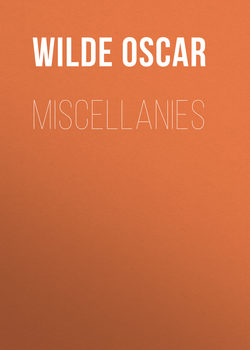Miscellanies

Реклама. ООО «ЛитРес», ИНН: 7719571260.
Оглавление
Wilde Oscar. Miscellanies
DEDICATION: TO WALTER LEDGER
INTRODUCTION
THE TOMB OF KEATS
THE GROSVENOR GALLERY, 1877
THE GROSVENOR GALLERY 1879
L’ENVOI
MRS. LANGTRY AS HESTER GRAZEBROOK
WOMAN’S DRESS
MORE RADICAL IDEAS UPON DRESS REFORM
MR. WHISTLER’S TEN O’CLOCK
THE RELATION OF DRESS TO ART: A NOTE IN BLACK AND WHITE ON MR. WHISTLER’S LECTURE
KEATS’S SONNET ON BLUE
THE AMERICAN INVASION
SERMONS IN STONES AT BLOOMSBURY: THE NEW SCULPTURE ROOM AT THE BRITISH MUSEUM
THE UNITY OF THE ARTS: A LECTURE AND A FIVE O’CLOCK
ART AT WILLIS’S ROOMS
MR. MORRIS ON TAPESTRY
SCULPTURE AT THE ARTS AND CRAFTS
PRINTING AND PRINTERS
THE BEAUTIES OF BOOKBINDING
THE CLOSE OF THE ARTS AND CRAFTS
ENGLISH POETESSES
LONDON MODELS
LETTER TO JOAQUIN MILLER
NOTES ON WHISTLER
REPLY TO WHISTLER
LETTERS ON DORIAN GRAY
AN ANGLO-INDIAN’S COMPLAINT
A HOUSE OF POMEGRANATES
PUPPETS AND ACTORS
LADY WINDERMERE’S FAN: AN EXPLANATION
SALOMÉ
THE THIRTEEN CLUB
THE ETHICS OF JOURNALISM
THE GREEN CARNATION
PHRASES AND PHILOSOPHIES FOR THE USE OF THE YOUNG
THE RISE OF HISTORICAL CRITICISM
LA SAINTE COURTISANE; OR, THE WOMAN COVERED WITH JEWELS
THE ENGLISH RENAISSANCE OF ART
HOUSE DECORATION
ART AND THE HANDICRAFTSMAN
LECTURE TO ART STUDENTS
BIBLIOGRAPHY BY STUART MASON
Отрывок из книги
The concluding volume of any collected edition is unavoidably fragmentary and desultory. And if this particular volume is no exception to a general tendency, it presents points of view in the author’s literary career which may have escaped his greatest admirers and detractors. The wide range of his knowledge and interests is more apparent than in some of his finished work.
What I believed to be only the fragment of an essay on Historical Criticism was already in the press, when accidentally I came across the remaining portions, in Wilde’s own handwriting; it is now complete though unhappily divided in this edition.1 Any doubt as to its authenticity, quite apart from the calligraphy, would vanish on reading such a characteristic passage as the following: – ‘.. For, it was in vain that the middle ages strove to guard the buried spirit of progress. When the dawn of the Greek spirit arose, the sepulchre was empty, the grave clothes laid aside. Humanity had risen from the dead.’ It was only Wilde who could contrive a literary conceit of that description; but readers will observe with different feelings, according to their temperament, that he never followed up the particular trend of thought developed in the essay. It is indeed more the work of the Berkeley Gold Medallist at Dublin, or the brilliant young Magdalen Demy than of the dramatist who was to write Salomé. The composition belongs to his Oxford days when he was the unsuccessful competitor for the Chancellor’s English Essay Prize. Perhaps Magdalen, which has never forgiven herself for nurturing the author of Ravenna, may be felicitated on having escaped the further intolerable honour that she might have suffered by seeing crowned again with paltry academic parsley the most highly gifted of all her children in the last century. Compared with the crude criticism on The Grosvenor Gallery (one of the earliest of Wilde’s published prose writings), Historical Criticism is singularly advanced and mature. Apart from his mere scholarship Wilde developed his literary and dramatic talent slowly. He told me that he was never regarded as a particularly precocious or clever youth. Indeed many old family friends and contemporary journalists maintain sturdily that the talent of his elder brother William was much more remarkable. In this opinion they are fortified, appropriately enough, by the late Clement Scott. I record this interesting view because it symbolises the familiar phenomenon that those nearest the mountain cannot appreciate its height.
.....
The next picture is divided into six compartments, each representing a day in the Creation of the World, under the symbol of an angel holding a crystal globe, within which is shown the work of a day. In the first compartment stands the lonely angel of the First Day, and within the crystal ball Light is being separated from Darkness. In the fourth compartment are four angels, and the crystal glows like a heated opal, for within it the creation of the Sun, Moon, and Stars is passing; the number of the angels increases, and the colours grow more vivid till we reach the sixth compartment, which shines afar off like a rainbow. Within it are the six angels of the Creation, each holding its crystal ball; and within the crystal of the sixth angel one can see Adam’s strong brown limbs and hero form, and the pale, beautiful body of Eve. At the feet also of these six winged messengers of the Creator is sitting the angel of the Seventh Day, who on a harp of gold is singing the glories of that coming day which we have not yet seen. The faces of the angels are pale and oval-shaped, in their eyes is the light of Wisdom and Love, and their lips seem as if they would speak to us; and strength and beauty are in their wings. They stand with naked feet, some on shell-strewn sands whereon tide has never washed nor storm broken, others it seems on pools of water, others on strange flowers; and their hair is like the bright glory round a saint’s head.
The scene of the third picture is laid on a long green valley by the sea; eight girls, handmaidens of the Goddess of Love, are collected by the margin of a long pool of clear water, whose surface no wandering wind or flapping bird has ruffled; but the large flat leaves of the water-lily float on it undisturbed, and clustering forget-me-nots rise here and there like heaps of scattered turquoise.
.....